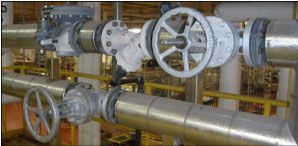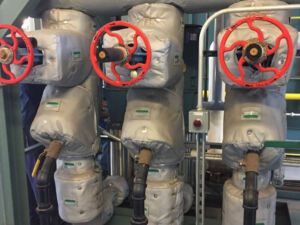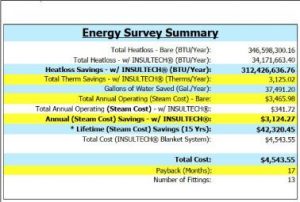There are many practices for achieving energy conservation, but among the simplest is blanketing industrial components with thermal insulation. While Shannon preaches “Just Insulate It,” blanketing a component for energy savings takes high-quality insulation designed and tested to standards and specifications like ASTM, ISO, and UL. Fundamentally, a facility or energy manager must insulate a component and keep it insulated to keep saving energy.
So, what stands in the way of such a simple energy-saving strategy?
Reason #1 – Facility managers regularly insulate easy-to-cover surfaces like pipes but aren’t sure if they can insulate complex surfaces.
 When managers are blanketing industrial components, particularly geometrically complex components, they tend to use hard-cover materials like fiberglass, mineral wool, foam glass, cellular glass, and calcium silicate. Or they use tough-to-remove jacketing materials like aluminum, stainless steel, or PVC.
When managers are blanketing industrial components, particularly geometrically complex components, they tend to use hard-cover materials like fiberglass, mineral wool, foam glass, cellular glass, and calcium silicate. Or they use tough-to-remove jacketing materials like aluminum, stainless steel, or PVC.- The problem: When maintenance teams peel back this insulation to service a component, the insulation doesn’t go back on the component.
Reason #2 – Traditional insulation (e.g., non-reusable fiberglass-filled jacketing) on flanges, valves, pumps, and other equipment means maintenance workers ultimately rip off the covering to service components.
- Operations and maintenance teams find it tough to take off traditional thermal insulation and acoustic insulation for inspection, service, and repair.
- Removing and repairing insulation means constantly logging and tallying problem areas and documenting the issues for future repair if it gets done at all.
Reason #3 – Repairing traditional insulation damaged by maintenance teams takes time and effort.
- Someone on the maintenance team must manage the upkeep of insulation.
- Whoever owns the upkeep must create a process and see that the results of these repairs happen regularly.
Reason #4 – There’s work making sure insulation contractors repair or reinstall ripped, torn, or worn-out traditional insulation.
- Roadblocks to getting contractors into a facility to perform the work include scheduling, finding a credible company, drafting a scope of work that clearly defines repairs, and reviewing a punch list to sign off on the insulation reinstalls and repairs.
Reason #5 – Most managers shoulder bigger, operational problems and sideline energy-saving and tactics.
- Insulation isn’t a priority. In fact, many managers don’t see efficiency as a tangible benefit. Instead, it’s a nuisance, including insulation.
- Maintaining their system means juggling personnel, operators, and budgets, so insulation and energy-saving strategies fall off the priority list.
So, what solves the problem?
The key to energy conservation through insulation is buying self-contained insulation that’s flexible and easy to install and reuse. Reusable blanket insulation (whether thermal insulation, acoustic insulation, safety blankets, safety shields, or fire blankets) conforms to complex contours, problematic surfaces, and covering each piece of equipment typically costs, on average, $350 to insulate. Once blanketed, the saving is $200 per year every year for up to 20 years (the typical lifespan of a reusable blanket).
Knowing What to Insulate
Along with picking the right product, a successful insulation solution requires an energy survey showing a template of opportunities for savings. Proper field data will drive an accurate survey. An accurate survey has these characteristics:
- A format that is data driven,
- field-tested, and
- highly structured.
Data includes operating temp, ambient temp, operating hours, an accurate description of the fittings, and steam/fuel cost. A well-constructed energy survey summarizes the information facility owners need to launch a project (e.g., project savings, project cost, simple payback period, and ROI such as the one at right 68.8%).
Every BTU saved is a savings in carbon. And, of course, energy efficiency is sustainability; a reduction in CO2, NOX, VOC, and water all add up. Imagine that one-time $350 investment above saving $3,200 over the reusable blanket’s life. Now envision a system with 300 to 500 fittings; the savings explode.
Achieving energy efficiency requires continuous improvement. When a facility owner sees an uninsulated steam component, the first step toward energy efficiency is to Just Insulate It.



